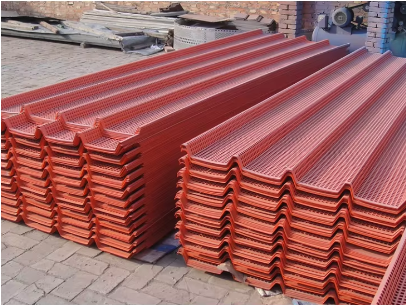Core Materials and Metal Sheet Preparation
Selecting Core Materials: EPS, Polyurethane, and Rockwool
Selecting the right core material is crucial for sandwich panel performance. Expanded Polystyrene (EPS) is favored for its lightweight properties and excellent insulation capabilities, making it ideal for energy-efficient buildings. It offers a cost-effective solution while maintaining structural integrity. Polyurethane, on the other hand, is renowned for its high thermal resistance and energy efficiency. This makes it suitable for environments needing robust temperature control, such as refrigerated warehouses. Rockwool stands out for its fire resistance and soundproofing characteristics, making it optimal for use in areas prioritizing safety, like industrial complexes. When choosing a core material, it's essential to consider project-specific requirements, costs, and environmental conditions to ensure optimal performance and user satisfaction.
Preparing Metal Sheets: Cutting and Surface Treatment
The preparation of metal sheets is a key step in sandwich panel manufacturing, as it influences both functionality and aesthetics. Choosing the right thickness and material, such as aluminum or pre-coated steel, depends on the desired strength and appearance of the panels. Precision in cutting metal sheets, achieved through techniques like laser cutting or CNC machining, ensures that the sheets fit perfectly within the panel structure. Surface treatments, such as galvanization and powder coating, are vital for enhancing the corrosion resistance and aesthetic appeal of the sheets, contributing to the longevity and visual quality of the panels. Thorough quality checks during this preparation stage are critical; they confirm that the sheets meet manufacturing standards and specifications, reflecting the high performance expected of the final product.
Key Steps in Sandwich Panel Manufacturing
Core Material Expansion and Stabilization
The expansion of core materials like EPS and Polyurethane plays a crucial role in sandwich panel manufacturing, impacting the insulation values significantly. For EPS, the beads are expanded through steam exposure, which enhances their insulation properties. Polyurethane is typically foamed, creating a uniform structure that offers high thermal resistance. Stabilization processes are essential to maintain structural integrity during expansion. Techniques such as controlled molding ensure that the expanded material remains consistent in density and performance. For example, standard expansion rates for EPS are around 40-50 times its original volume, underscoring its effectiveness in insulation applications.
Lamination Process: Heat, Pressure, and Adhesive Application
Lamination constitutes a critical step in creating sandwich panels, relying on heat and pressure to bond the layers. This process involves a lamination press where adhesives are applied, tailored to the specific core material and outer layers used. The adhesive ensures a secure bond between the metal sheets and core, optimizing durability. Modern adhesion techniques surpass traditional methods by increasing efficiency and bond strength. Studies reveal that advanced adhesives enhance production speeds by 15-20%, showcasing technological advancements in this domain. Understanding the intricate roles of heat, pressure, and adhesive in lamination is paramount for achieving high-quality panels.
Curing and Cooling for Structural Integrity
The curing process solidifies the adhesive, playing a pivotal role in sandwich panel manufacturing. Adequate curing ensures optimal bond strength, preventing structural failures. Once cured, panels undergo cooling, an essential step for stabilizing the structure and enhancing performance characteristics. Improper curing can lead to reduced bond integrity, as highlighted by case studies demonstrating how insufficient curing compromises durability and thermal efficiency. Expert opinions underscore the importance of precise curing and cooling techniques to ensure the longevity and functionality of sandwich panels.
Finishing: Cutting, Edge Profiling, and Coating
Finishing processes in sandwich panel production involve precision cutting and edge profiling, which are instrumental in ensuring product quality. Panels are meticulously cut to specified lengths, while edge profiling enhances their aesthetic and functional aspects. Various coating options, including powder and PVC, boost the insulation, durability, and visual appeal. Quality assurance during this stage is crucial to detect defects and uphold consistency. Employing rigorous checks helps maintain adherence to standards and specifications, ensuring that finished panels retain their optimum insulation efficiency and load-bearing capacity.
The Role of Bonding Agents in Structural Performance
Ensuring Adhesion Between Dissimilar Materials
Bonding agents are pivotal in achieving secure adhesion between the various materials that comprise sandwich panels. These panels often involve different substrates, like metals and polymers, which have distinct properties driving the need for specialized adhesives. Bonding agents such as polyurethane and epoxy adhesives mitigate issues related to thermal expansion and contraction, ensuring that the layers remain intact regardless of temperature fluctuations. For example, a metal-foam pairing requires an adhesive that accommodates the differential expansion of metal without compromising structural integrity.
Minimizing Thermal Bridging for Insulation Efficiency
Thermal bridging is a critical concern in sandwich panel installations, as it causes energy loss by allowing heat to pass through less insulated sections. Effective bonding agents are designed to limit this phenomenon by providing continuous insulation across the panel surfaces, thereby enhancing energy efficiency. By creating a seamless bond, adhesives reduce the potential for thermal bridging, minimizing heat transfer and improving the thermal performance of the panels. This is crucial for reducing energy costs and maintaining comfortable interior temperatures in buildings.
Enhancing Moisture Resistance and Durability
Bonding agents also play a critical role in enhancing the moisture resistance and overall durability of sandwich panels. As quality adhesives help create a robust seal, they prevent moisture ingress, protecting the core material and extending the panel's lifespan. Studies have shown that using the right adhesive can significantly enhance the durability of panels in harsh environments, ensuring longevity and performance. By preventing moisture-related degradation, bonding agents contribute to the structural health and effectiveness of sandwich panels in various applications.
Types of Adhesives in Sandwich Panel Manufacturing
Epoxy Adhesives: High-Strength Bonding
Epoxy adhesives are renowned for their robust chemical properties, which make them ideal for high-strength bonding applications in sandwich panel manufacturing. Their ability to form durable connections ensures the structural integrity of load-bearing panels. AERoBOND, developed by NASA Langley Research Center, exemplifies the efficiency of epoxy adhesives, combining unique barrier ply layers to mitigate excessive mixing and enhance bonding strength. This approach has found success in various large-scale applications, including aerospace and marine sectors, by providing predictable mechanical properties and reliable adhesion.
Polyurethane Adhesives: Flexibility and Weather Resistance
Polyurethane adhesives offer exceptional flexibility and resilience, making them suitable for sandwich panels exposed to diverse weather conditions. Their adaptability allows these adhesives to retain their bonding effectiveness amidst temperature fluctuations and moisture variations. Case studies highlight polyurethane's role in constructing panels for outdoor installations in regions with high humidity or temperature extremes. This adhesive's formulation enables it to maintain structural performance without compromising its bonding capability, exemplifying its utility in demanding environments.
Acrylic and Hybrid Polymer Options
Acrylic and hybrid polymer adhesives bring unique properties to the table in sandwich panel manufacturing. These adhesives are prized for their balance of strength and flexibility, making them apt for various applications. Recent advancements in adhesive technology have bolstered their performance by enhancing their ability to bond diverse materials reliably, boosting manufacturing efficiency. This innovation allows manufacturers to choose adhesives tailored to specific requirements, such as enhanced moisture resistance or heat tolerance, proving critical in expanding the potential uses of sandwich panels.
Quality Control and Testing Protocols
Shear and Peel Strength Testing
Shear and peel strength testing are critical in ensuring the structural integrity and durability of sandwich panels. These tests assess the adhesive's capability to withstand forces that might cause failure in real-world applications. Ensuring the quality of adhesives is paramount, adhering to standardized testing methods such as ASTM D1002 for lap shear strength and ASTM D1781 for peel strength testing. Industry benchmarks set specific criteria, which help in maintaining consistent quality and performance in adhesive bonding. These tests are indispensable for confirming that the adhesive can securely bond components without compromise.
Thermal and Load-Bearing Capacity Assessments
Thermal assessments provide crucial insights into the insulation properties of sandwich panels, helping manufacturers ensure their panels meet necessary energy efficiency standards. The panels must perform well under varied temperature conditions, which are evaluated using specific tests to simulate real-world thermal environments. Similarly, load-bearing capacity testing ensures sandwich panels can support structural requirements in different applications, from architectural to aerospace. This testing process typically includes assessing panels under simulated load conditions, verifying they can sustain the expected weight and pressure. These assessments are essential for certifying that panels comply with safety standards and are reliable in diverse operational scenarios.
FAQ Section
What are the key materials used in sandwich panels?
The key materials in sandwich panels are core materials like Expanded Polystyrene (EPS), Polyurethane, and Rockwool, and outer metal sheets such as aluminum or pre-coated steel.
Why is choosing the right adhesive important for sandwich panels?
The correct adhesive ensures strong bonding between dissimilar materials, minimizes thermal bridging, and enhances moisture resistance and durability.
How is thermal performance assessed in sandwich panels?
Thermal performance is assessed through specific tests that simulate real-world thermal environments to ensure the panels meet necessary energy efficiency standards.

 EN
EN







































